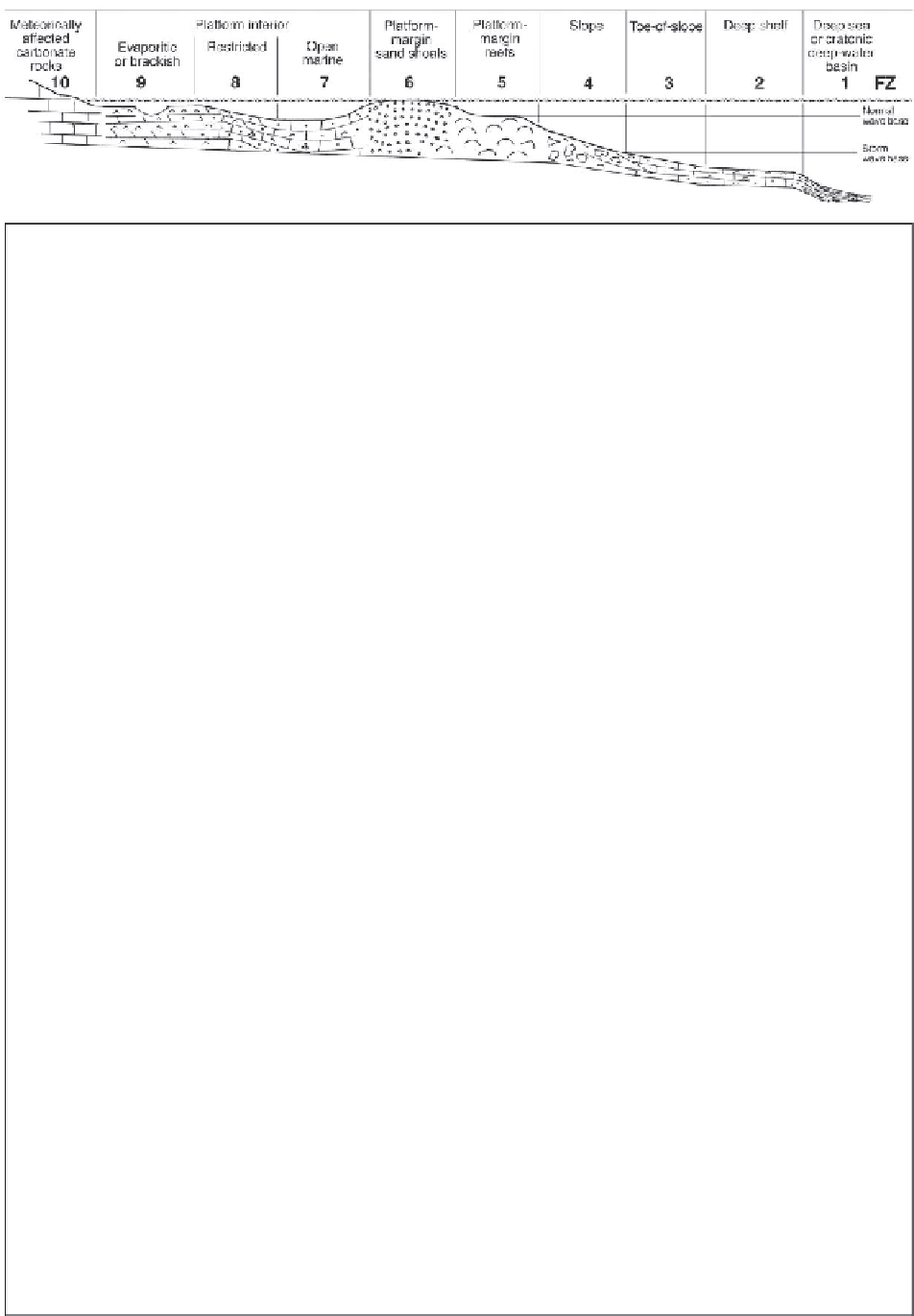Geology Reference
In-Depth Information
Fig. 14.1.
Rimmed carbonate platform:
The Standard Facies
Zones of the modified Wilson model.
Box 14.1.
Standard Facies Zones (FZ) of the modified Wilson model describing a rimmed carbonate platform.
Basin and deep shelf
FZ 1A Deep Sea
Setting:
Below wave base and below the euphotic zone
in oceanic deep water. Water depth several hundreds to
several thousands of meters. Wide facies belt.
Sediments:
Entire suite of deep-sea sediments includ-
ing pelagic clay, siliceous and carbonate ooze, hemipelagic
muds, turbidites. Adjacent to platforms mixtures of pelagic
and platform-derived material (peri-platform oozes and
muds). Bedding highly variable, often thin-bedded. Rock
color: dark, reddish or light depending on differences in
oxidizing and reducing conditions.
Biota:
Predominantly plankton, typical oceanic assem-
blages, sometimes associated with autochthonous benthic
fossils. In peri-platform sediments up to 75% shallow-wa-
ter benthos.
Common lithofacies:
Pelagic mudstone and wackestone;
marls; allochthonous packstone, grainstone, breccia.
Biota
: Diverse shelly fauna indicating normal marine
conditions. Infauna and epifauna. Minor plankton. Steno-
haline biota conspicuous (e.g. brachiopods, echinoderms).
Common lithofacies:
Wackestone. Occasional grain-
stones. Marls and shales.
Toe-of-slope and slope
FZ 3 Toeofslope apron (deep shelf margin)
Setting:
Below wave base and barely at oxygen level.
Moderately inclined sea floor (over 1.5°) basinward of
steeper slopes. Water depths similar to FZ 2 and perhaps
200 to 300 m. Narrow facies belt.
Sediments:
Mostly pure fine-grained carbonates, in
some places cherty, rare intercalations of terrigenous muds.
Pelagic material admixed with fine-grained detritus moved
off from adjacent shallow shelves. Grain size highly vari-
able. Typical are well-defined graded beds or breccia lay-
ers (turbidites, debris-flow deposits) intercalated in fine-
grained background sediment. Rock color: dark to light.
Biota
: Mostly redeposited shallow-water benthos; some
deep-water benthos and plankton.
Common lithofacies:
Lime mudstones; allochthonous
packstones and grainstones. Shale partings.
FZ 4 Slope
Setting:
Distinctly inclined sea floor (commonly 5° to
nearly vertical) seaward of platform margins. Very narrow
facies belt.
Sediments:
Predominantly reworked platform material
and pelagic admixtures. Highly variable grain size. End
members are gentle muddy slopes with much slumping,
and sandy or rubbly slopes with steep foresets. Rock color:
dark to light.
Biota:
Mostly redeposited shallow-water benthos, en-
crusting slope benthos and some deep-water benthos and
plankton. The facies may be very fossiliferous.
Common lithofacies:
Mudstone; allochthonous pack-
stone and grainstone; rudstone and floatstone. Breccia.
Upper slope reefs and platform-margin reefs
FZ 5 Platformmargin reefs
Setting:
(a) Organically stabilized mud mounds on up-
per slope; (b) ramps with knoll reefs and sand shoals;
(c) wave-resistant barrier reefs rimming the platform. Water
depths generally some meters,but some hundred meters
for mud mounds. Very narrow facies belt.
Sediments:
Almost pure carbonates of very variable
grain size. Massive limestones and dolomites. Masses or
patches of various types of boundstones. Reef cavities filled
with internal sediment or carbonate cements; multiple gen-
erations of construction, encrustation, boring and destruc-
tion. Rock color: light.
FZ 1B Cratonic deepwater basin
Setting:
Below wave base, below the euphotic zone. Wa-
ter depth about 30 m to several 100s m. Wide facies belt.
Sediments:
Similar to 1A. Hemipelagic muds very com-
mon. Occasionally anhydrite. Sometimes common cherts.
Anoxic conditions fairly common (high organic content;
lack of bioturbation). Dark thin limestone beds and dark
shale beds. Lime mudstones, calcisiltites. Rock color: dark
brown and black (due to organic matter) and reddish (due
to slow sedimentation).
Biota:
Predominantly nekton (e.g. ammonites) and
plankton (radiolarians, pelagic foraminifera, calpionellids,
coquinas of thin-shelled bivalves). Occasionally benthos
(abundant sponge spicules).
Common lithofacies
: Lime mudstone, wackestone,
packstones. Marls. Anhydrite.
FZ 2 Deep shelf
Setting
: Below fair-weather wave base but within the
reach of extreme storm waves. Within or just below the
euphotic zone. Forming plateaus between active platforms
and deeper basins. The plateaus are commonly established
on top of drowned platforms. Water depth tens of meters
to hundreds of meters. Normal salinity, oxygenated waters
with good current circulation. Wide facies belt.
Sediments:
Mostly carbonate (highly fossiliferous lime-
stone) interbedded with marl beds. Skeletal wackestone
and whole fossil wackestone; some grainstone and co-
quinas. Matrix commonly pelmicrite. Some silica. Well
bioturbated. Well bedded. Bedding thin to medium, wavy
to nodular. Rock color: gray, green, red and brown depend-
ing on variable oxidizing and reducing conditions.

